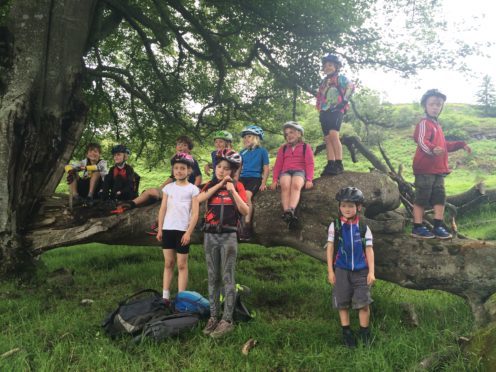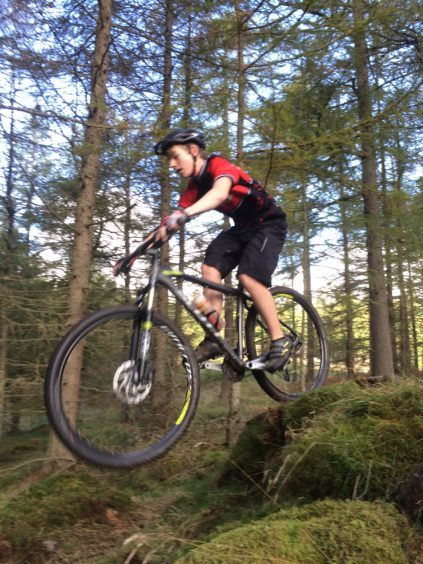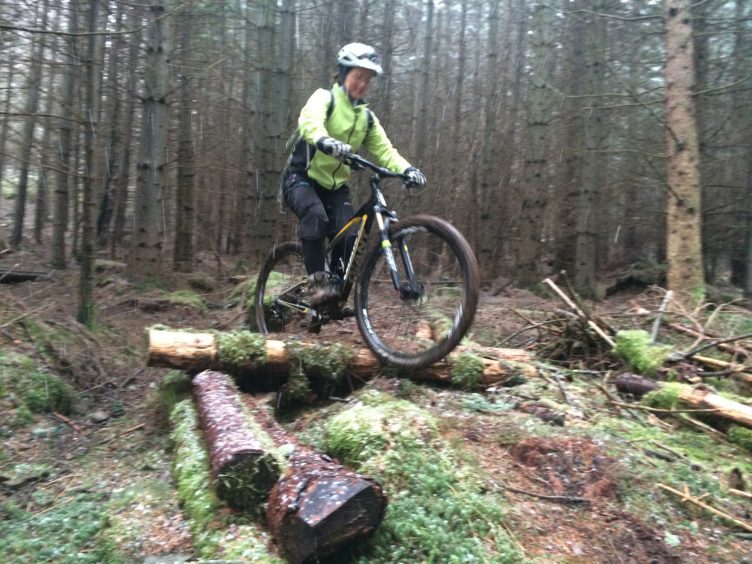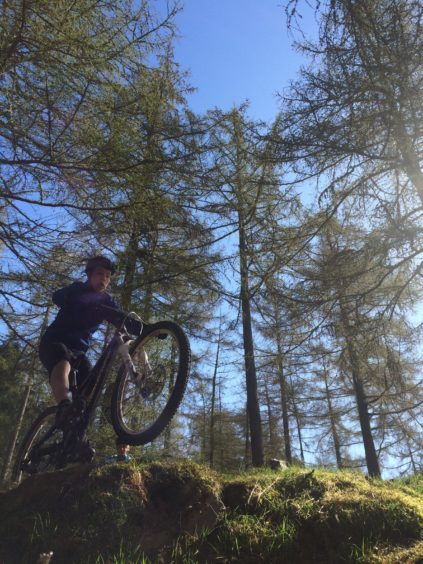Washing down your mountain bike after a particularly muddy ride makes good sense; it keeps the parts running smoothly and ensures that your prized steed will be riding trails for many years to come.
There is also another reason, namely Phytophthora ramorum – a fungus-like pathogen, also known as water mould and which leads to larch disease.
Unfortunately, larch disease is spreading through the UK and, once infected, the only control available is felling the infected trees. The disease is a worldwide issue, but in Europe, so far, only the UK, Ireland and the Netherlands have reported it in trees.
In Scotland, the outbreaks have been widespread with concentrated devastation around the south-west around Dumfries and Galloway. However, recent outbreaks have been spreading and Tayside, and in particular Highland Perthshire, have seen many cases in the last 12 months.
The first finding in the UK was in a garden centre in Sussex in 2002 on a viburnum plant and since then has been found to affect larch, beech and sweet chestnut trees.
It is unknown where and when the pathogen first entered the UK, but it seems that the invasive and widespread rhododendron, which produces large numbers of spores, is a culprit in accelerating the spread.
However, spores can travel over several miles in air-currents and watercourses.
It can also be spread on footwear, dogs’ (and wild animals’) paws and vehicles, including bicycle wheels. Currently, there is no effective treatment to kill the pathogen and the only method of control so far is preventing further spread by felling any area of trees found to be infected.
So as cyclists, how can we do our bit to prevent further spread of the disease? Tree needles and soil are the main risks for carrying the pathogen, especially when wet, so quite simply, the answer is to wash off any plant debris and mud from our bike, shoes and kit before leaving trail centres and forests and avoid taking a muddy bike between destinations. Many trail centres have bike-washing facilities on-site and if the places you ride don’t you could always invest in a small portable bike-washer.
It is also worth checking your clothing, including hoods, helmets and back-packs, for pine-needles and other debris. As we also spend a lot of time in forests we should also keep a lookout for the symptoms of larch disease and report them – the Forestry Commission has a Forest Research Tree Alert report you can complete.
The symptoms to look out for on trees include lesions, which exude fluid from infected bark that dries as a black crust.
The future prospect for our forests depends on how well it is currently contained and whether the pathogen starts to infect other species of tree and plant. Scotland has huge forests upon which much of our economy depends and that we have unlimited access to – thanks to our unparalleled outdoor access laws. With that access come certain responsibilities and, as regular users of our fantastic countryside, it seems only reasonable that we take precautions to ensure that our access isn’t diminished in the future and we still have forests to ride through for many years to come.
Join the Blazing Saddles Strava Club at: www.strava.com/clubs/BlazingSaddlesWeekendCourier
Where to ride: Aberfoyle Bike Park – to find the Bike Park, head down National Cycle Route 7 from the Wool Centre. In Aberfoyle and it’s about 200 metres along on the right or if you’re coming from Gartmore along NCR 7 it’s on your left about half a mile after the Rob Roy Hotel.
Details: Aberfoyle bike park is relatively small compared to some of the other trail centres we have in Scotland, but it packs a lot into its short course. There are rock gardens, skinnies, drops, jumps and berms, all of which are ideal for honing your skills for the bigger trails. There are many other trails to explore in and around Aberfoyle.
Check out BikeTrossachs.org.uk for more details.
Washing down your mountain bike after a particularly muddy ride makes good sense; it keeps the parts running smoothly and ensures that your prized steed will be riding trails for many years to come.
There is also another reason, namely Phytophthora ramorum – a fungus-like pathogen, also known as water mould and which leads to larch disease.
Unfortunately, larch disease is spreading through the UK and, once infected, the only control available is felling the infected trees. The disease is a worldwide issue, but in Europe, so far, only the UK, Ireland and the Netherlands have reported it in trees.
In Scotland, the outbreaks have been widespread with concentrated devastation around the south-west around Dumfries and Galloway. However, recent outbreaks have been spreading and Tayside, and in particular Highland Perthshire, have seen many cases in the last 12 months.
The first finding in the UK was in a garden centre in Sussex in 2002 on a viburnum plant and since then has been found to affect larch, beech and sweet chestnut trees.
It is unknown where and when the pathogen first entered the UK, but it seems that the invasive and widespread rhododendron, which produces large numbers of spores, is a culprit in accelerating the spread.
However, spores can travel over several miles in air-currents and watercourses.
It can also be spread on footwear, dogs’ (and wild animals’) paws and vehicles, including bicycle wheels. Currently, there is no effective treatment to kill the pathogen and the only method of control so far is preventing further spread by felling any area of trees found to be infected.
So as cyclists, how can we do our bit to prevent further spread of the disease? Tree needles and soil are the main risks for carrying the pathogen, especially when wet, so quite simply, the answer is to wash off any plant debris and mud from our bike, shoes and kit before leaving trail centres and forests and avoid taking a muddy bike between destinations. Many trail centres have bike-washing facilities on-site and if the places you ride don’t you could always invest in a small portable bike-washer.
It is also worth checking your clothing, including hoods, helmets and back-packs, for pine-needles and other debris. As we also spend a lot of time in forests we should also keep a lookout for the symptoms of larch disease and report them – the Forestry Commission has a Forest Research Tree Alert report you can complete. The symptoms to look out for on trees include lesions, which exude fluid from infected bark that dries as a black crust. The future prospect for our forests depends on how well it is currently contained and whether the pathogen starts to infect other species of tree and plant. Scotland has huge forests upon which much of our economy depends and that we have unlimited access to – thanks to our unparalleled outdoor access laws. W
ith that access come certain responsibilities and, as regular users of our fantastic countryside, it seems only reasonable that we take precautions to ensure that our access isn’t diminished in the future and we still have forests to ride through for many years to come.
Join the Blazing Saddles Strava Club at: www.strava.com/clubs/BlazingSaddlesWeekendCourier
Where to ride: Aberfoyle Bike Park – to find the Bike Park, head down National Cycle Route 7 from the Wool Centre. In Aberfoyle and it’s about 200 metres along on the right or if you’re coming from Gartmore along NCR 7 it’s on your left about half a mile after the Rob Roy Hotel.
Details: Aberfoyle bike park is relatively small compared to some of the other trail centres we have in Scotland, but it packs a lot into its short course. There are rock gardens, skinnies, drops, jumps and berms, all of which are ideal for honing your skills for the bigger trails. There are many other trails to explore in and around Aberfoyle.
Check out BikeTrossachs.org.uk for more details.













